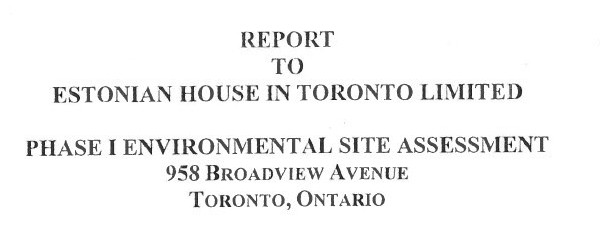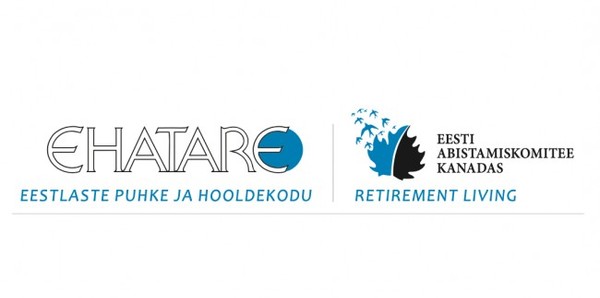
Aside from the roof repair, the 3 professionals concluded that the remainder of the Estonian House, and the original Chester Public School portion, did not have any structural, health or environmental issues that would make the building unusable or pose a risk to any of its regular users or visitors. Their assessment echoed the findings of a Phase 1 Environmental Site Assessment (ESA) that was performed on Estonian House by Decommissioning Consulting Services Limited (DCS Ltd) in October 2012. The DCS report did not identify anything specific that required urgent work, and now years later the three professionals have concluded that with regular, standard maintenance projects 958 Broadview could service the community for years to come. The DCS Ltd report did note, however, that if the building were to be demolished or extensively renovated certain precautions would have to be taken when handling particular materials.
At more than 100 pages of analysis, historic materials, maps, charts and tables, the DCS Ltd report reviewing Estonian House that was obtained for this reporting is significantly more detailed than the Phase 1 report for 11 Madison Ave. When discussions related to “Eesti Maja Tulevik” began, much of the emphasis was put on the unsustainable nature of 958 Broadview, it’s poor state, declining usage and age. Ironically, one item that the original Chester Public School and 11 Madison have in common is that both were built around 1890; which is confirmed by both Phase 1 reports.
As for the Estonian House’s overall health, DCS’ 2012 report did not highlight any particular defect with regard to the structure, infrastructure or other major element that would cause grave concern. On page 2-4 of their review DCS quoted a 2004 Property Underwriters’ Report on Estonian House which stated: “that there were two additions / renovations at the front and rear of the building that were in good condition.” That same 2004 report went on to say: “The remainder of the building was reported as being very old but well maintained.” A follow-up Property Underwriters’ Report in 2006 concluded that the building was “mainly occupied by a well maintained community centre.” There were also Risk Inspection Reports for 2004 and 2006 which provided overall scorecards for various aspects of Estonian House’s structure, infrastructure and operation. Generally, the building scored “Average” or met the required standards. In the “Recommendations” section of the reports inspectors graded building features based on the need for “Critical”, “Important” or “Desirable Improvement.” In 2004 and 2006 the inspectors concluded that “NONE” were required. On the “Risk Score” table where general Property, Liability and Crime are summarized on a scale where 1 is considered “Excellent” and 9 is considered “Poor” the Estonian House scored nothing weaker than 3 in both 2004 and 2006. Sure, there’s a lot of numbers, different grading standards and references to multiple regulatory requirements, but one thing is clear from reviewing the DCS report, there is nothing to suggest the sky is falling. Compare it to reading a student’s report card and you would probably come away saying that with a little more studying the grades could be a solid B or better.
So what of the asbestos, for example? During Estonian House annual and special meetings it has been mentioned that asbestos exists in parts of the building. It’s true, in addition to hydrochlorofluorocarbon (HCFC) refrigerant in the air conditioners, mercury in some of the lighting, elevated levels of salt in the parking lot area as well as possible lead in old paints and plumbing, there is asbestos in the building. But as the authors of the 2012 DCS report noted, as long as these items are maintained by qualified personnel and/or not disturbed (i.e. demolished or removed during construction), none of these environmental realities is irregular, poses a health hazard or means that the building was operating outside of regulatory compliance. DCS explained the level of attention these materials deserve in the introduction of their report:
“Hazardous materials such as asbestos-containing material (friable and non-friable), lead, mercury, PCBs and silica are expected to be present in the building. Building materials possibly containing asbestos that may pose a significant concern in the day to day operations of the facility include, but are not limited to, exposed thermal insulation on piping observed in both mechanical rooms and in several other rooms in the basement. Non-friable asbestos-containing materials, silica in construction materials such as concrete and brick, and small quantities of mercury as a vapour within florescent light tubes and in the thermostats in the building pose no human health or environmental concern with respect to the ongoing use or utility of the building. Asbestos-containing materials and other designated substances need to be identified and addressed if building demolition is contemplated or if renovations in the building are likely to disturb the materials containing the designated substances.”
In short, if the materials are not disturbed they pose no threat. If facilities are maintained, then those parts of the building’s infrastructure can continue to service the community’s needs. Similar to Toomas Saar’s comments in his review, page 4-4 of DCS’ report verified the only areas that “may pose a significant concern” are the “exposed thermal insulation on piping observed in both mechanical rooms and in several other rooms in the basement.” Different professionals with basically the same findings.
Certainly, when the time comes to replace or remove certain infrastructure, such as pipes leading to or exiting the boiler in the basement, then proper precautions must be taken. On page 4-6 of the DCS report it says:
“The presence of these designated substances do not comprise a significant concern and need only be addressed if building demolition is contemplated or if renovations in the building are likely to disturb the materials containing the designated substances. The Occupational Health and Safety Act requires that the presence of these substances and their concentrations be identified and that potential contractors be notified of their presence at the bidding stage for any intrusive renovation, repair or construction work that might result in their disturbance.”
When the time comes, contractors should be made aware of what they might be dealing with, otherwise, exercise appropriate care and the building can continue to operate.
Considering the tone of the presentations made to the Toronto Estonian community as early as 2013, you would think that the 2012 Phase 1 Environmental Site Assessment (ESA) by Decommissioning Consulting Services Limited would have included a list of deficiencies, and that those structural or environmental deficiencies led the inspectors to conclude that 958 Broadview is desperately in need of critical maintenance, rebuilding or is unsustainable based on its physical condition. That type of language simply doesn’t exist in the DCS report. There are no conclusions or recommendations that suggest the House is falling apart or that the community should leave the building as soon as possible.
What sparked the change in how community leaders viewed Estonian House from the time DCS Ltd presented their report in October 2012 to the days when discussions began with various condo developers? In January 2015 the Estonian House Board asked and got 95% of shareholders to ratify a Letter of Intent with Tribute. Supposedly, the DCS report was one “report” used to support the sentiment that the House couldn’t serve Estonian Canadians too much longer. Skip over the Alterra deal, fast forward to the current discussions to rebuild at Madison and there doesn’t seem to be any third-party analysis provided or released to the community that shows that the health of the building at 958 Broadview is in critical condition. If the sky isn’t falling and the House isn’t falling apart, should the chips still fall where they may?
Allan Meiusi
EWR Contributor
Related: Toronto Eesti Maja tulevik
Madison Project “Due Diligence” Part 1
Madison Project “Due Diligence” Part 2
Madison Project “Due Diligence” Part 3 – School Season Neighbours
Déjà vu all over again - Part 4
Part 5 – "Cash out, but will it cash in?”
Part 6 – "11 Madison: Check the box.”






















